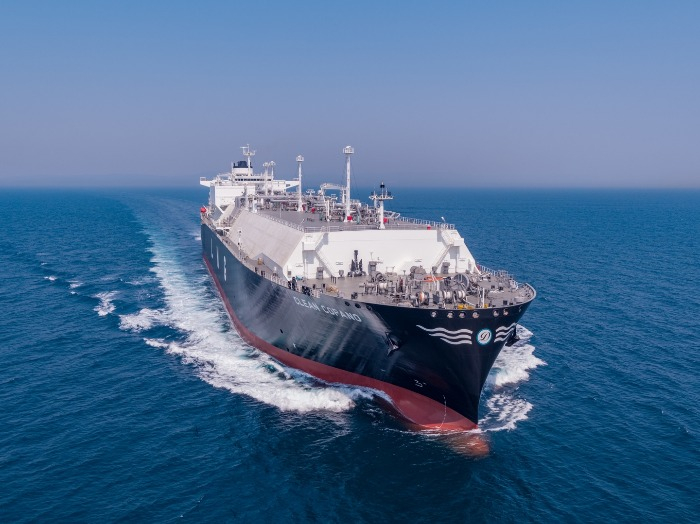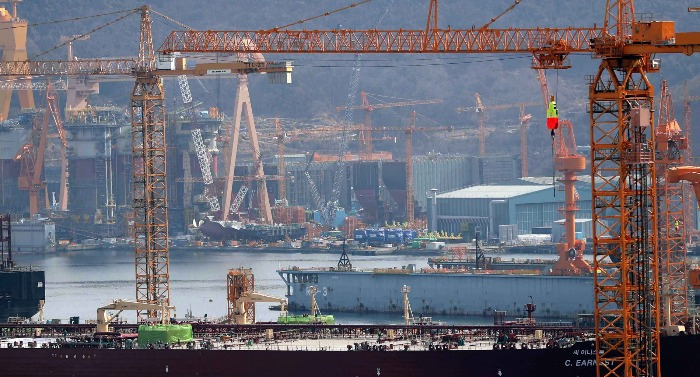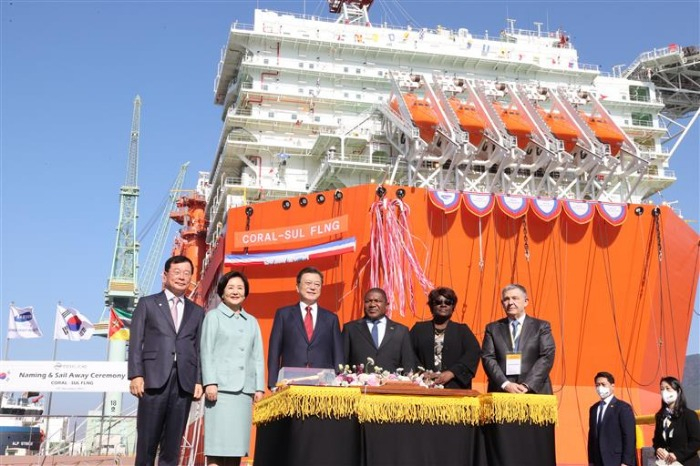Korean shipyards feel tailwind from emission rules
Their bulging order backlogs allow them to focus on high-value-added vessels
By Apr 23, 2023 (Gmt+09:00)
LG Chem to sell water filter business to Glenwood PE for $692 million


Kyobo Life poised to buy Japan’s SBI Group-owned savings bank


KT&G eyes overseas M&A after rejecting activist fund's offer


StockX in merger talks with Naver’s online reseller Kream


Mirae Asset to be named Korea Post’s core real estate fund operator



Tighter environmental rules and higher energy prices are providing tailwinds for South Korean shipbuilders, which have swept orders for eco-friendly and fuel-efficient vessels.
Hyundai Samho Heavy Industries Co. has bagged $5.08 billion worth of orders to build 30 ships so far this year, already exceeding its 4.6 trillion won ($3.5 billion) revenue for the whole of 2022 on a stand-alone basis.
The year-to-date orders received are almost double its target of $2.6 billion for this year.
Most of the vessels are eco-friendly, high-value-added models: 19 ships fueled by methanol; seven by liquefied natural gas (LNG); and two by liquefied petroleum gas (LPG).
Its affiliate Hyundai Mipo Dockyard Co. has won $1.17 billion in orders so far this year, achieving one-third of its annual target of $3.7 billion.
Thanks to the string of record-setting orders, Korea Shipbuilding & Offshore Engineering Co. (KSOE), a holding company of the two shipbuilders, and other South Korean shipyards have built their backlogs of work for the next three years.
Their bulging order backlogs allow them to be selective in securing orders, shifting their focus toward high-priced models.
For Hyundai Heavy Industries Co., also under KOSE, nine out of the 10 vessels, for which it has scooped orders this year, are powered by LNG, LPG and other eco-friendly fuels.
In total, the value of its orders received this year reached a combined $1.47 billion, equivalent to 15.4% of its annual target.

Last year, South Korean shipbuilders swept 70% of LNG carrier orders equivalent to 10.1 million compensated gross tonnage (CGT).
According to Clarksons Research, eco-friendly ships accounted for 71% of new shipbuilding orders placed in the third quarter of 2022 worldwide.
The International Maritime Organization calls for cutting greenhouse gas emissions from international shipping by at least half by 2050.
Such trends are expected to give an edge to Korean shipyards, already the world’s dominant shipbuilders.
Higher energy prices add to their bright outlook thanks to growing demand for energy-efficient vessels.
Chevron Corp., a US oil refiner, is reportedly seeking to build six new LNG carriers, which will mark its first LNG ship order in 10 years.
QatarEnergy is understood to look to boost its Q-Max fleet with up to 12 new LNG ships.

Samsung Heavy Industries Co. has won $2.52 billion in orders so far this year, or one-quarter of its $9.5 billion target of orders for 2023.
Setting it apart from homegrown rivals, its orders include floating LNG (FLUNG) facilities, or offshore development constructed on a ship or a barge to produce natural gas from a remote field.
Given the sophisticated technology required to build the facilities, it is expected to win additional orders related to those projects.
Daewoo Shipbuilding & Marine Engineering Co. (DSME) has snapped a combined $1.06 billion in orders for five vessels, including four LNG carriers. The figure represents 15% of its annual target of $6.98 billion.
Its takeover by South Korea’s Hanwha Group has been delayed amid concerns that its merger into the defense-to-chemical conglomerate could restrict competition in the shipbuilding and ship parts industries.
Meanwhile, Korean shipbuilders may suffer a headwind due to the lack of workforce following the protracted slowdown in the shipbuilding industry in the past few years.
Their unfavorable working conditions have put Koreans off from their shipyards as well. Currently, about 8,400 foreign employees are working at their dockyards.
Write to Jae-Fu Kim and Mi-Sun Kang at hu@hankyung.com
Yeonhee Kim edited this article
-
 Shipping & ShipbuildingKorean shipbuilders yield No.1 spot to Chinese rivals in March
Shipping & ShipbuildingKorean shipbuilders yield No.1 spot to Chinese rivals in MarchApr 05, 2023 (Gmt+09:00)
1 Min read -
 Shipping & ShipbuildingHanwha's takeover of DSME likely to get conditional approval
Shipping & ShipbuildingHanwha's takeover of DSME likely to get conditional approvalApr 04, 2023 (Gmt+09:00)
1 Min read -
 Shipping & ShipbuildingSamsung Heavy wins order $512 mn for two LNG carriers
Shipping & ShipbuildingSamsung Heavy wins order $512 mn for two LNG carriersApr 03, 2023 (Gmt+09:00)
1 Min read -
 Shipping & ShipbuildingKorea's KSOE lands $240 mn order for LPG carriers
Shipping & ShipbuildingKorea's KSOE lands $240 mn order for LPG carriersMar 21, 2023 (Gmt+09:00)
1 Min read -
 Shipping & ShipbuildingKSOE wins order for 2 mid-sized gas carriers at $146 mn
Shipping & ShipbuildingKSOE wins order for 2 mid-sized gas carriers at $146 mnMar 10, 2023 (Gmt+09:00)
1 Min read -
 Shipping & ShipbuildingKorea's KSOE wins order for 3 LNG carriers at $770 mn
Shipping & ShipbuildingKorea's KSOE wins order for 3 LNG carriers at $770 mnMar 03, 2023 (Gmt+09:00)
1 Min read -
 Shipping & ShipbuildingKSOE wins order for 4 petrochem product carriers
Shipping & ShipbuildingKSOE wins order for 4 petrochem product carriersMar 02, 2023 (Gmt+09:00)
1 Min read -
 Shipping & ShipbuildingSamsung Heavy wins $495 million order for two LNG ships
Shipping & ShipbuildingSamsung Heavy wins $495 million order for two LNG shipsFeb 01, 2023 (Gmt+09:00)
1 Min read -
 Shipping & ShipbuildingKSOE wins this year's first LNG carrier order worth $783 million
Shipping & ShipbuildingKSOE wins this year's first LNG carrier order worth $783 millionJan 17, 2023 (Gmt+09:00)
1 Min read


